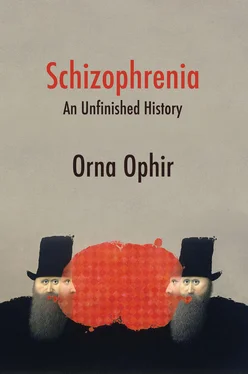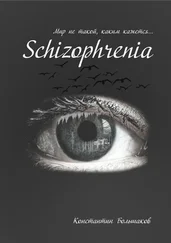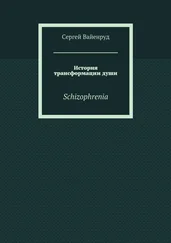Although these early Hippocratic texts understand the differences between mental health and illness in terms of a humoral spectrum, they also contain attempts to categorize and differentiate the respective states of balance and imbalance. For example, The Sacred Disease offers the following differentiation between various kinds of madness: “Those who are mad through phlegm are quiet, and neither shout nor make a disturbance; those maddened through bile are noisy, evil-doers and restless, always doing something inopportune.” 42If the brain is chilled, “the patient suffers from causeless distress and anguish,” but when the brain is suddenly heated, the patient “shouts and cries at night.” 43
While it differentiates these types of madness based on the various humors, the Sacred Disease suggests that these states could also be part of normal occurrences such as dreams. Like these nightly visions, they too are reversible. As the Hippocratic author explains, the heating of the brain (which is caused by an abundance of blood that rushes into it, and boils it) can also follow a fearful dream. When the person wakes up and regains his consciousness, the blood is dispersed into the veins once more, and the “mad” manifestations cease. The text also argues that the same phenomenon can occur in the waking state, when “the face is flushed, and the eyes are red, mostly when a man is afraid and his mind contemplates some evil act.” 44
The Romans, for their part, also recorded a variety of types of madness. The first known psychiatric taxonomy of antiquity in the Western tradition, De Medicina , was written by Cornelius Celsus. 45In this work, Celsus distinguishes between “three types of madness” ( tria genera insaniae ), which are classified according to their duration: madness that is similar to the Greek phrenitis is an acute, quick furor; mania is a longer insanity without fever; and, lastly, longissimum corresponds to melancholia . 46Thumiger finds three elements in this Roman text that are relevant to later discussions of madness: first, the distinction between the acute and the chronic; second, the identification of somatic causes (e.g., fever); and, finally, the division of madness into three types (in this case, phrenitis, mania , and melancholia ). Interestingly, Celsus further adds the original idea that insanity can be treated not only by balancing the body’s humors, but also by a form of psychotherapy, occupational therapy, cognitive exercises, and social activities. 47
The most famous Greek doctor, however, is Galen of Pergamon (130–210 CE), whose work remained deeply influential among medical professionals and other scholars, until late into the seventeenth century. Significantly, Galen did not pay much attention to the classification of disorders, or to discussions of diseases or syndromes. 48Instead, as was the case in the Hebrew Bible and the tradition of commentary standing on its shoulders, in The Passions and Errors of the Soul , Galen sees madness as the absence of the single defining human characteristic, that is, “the special gift of reason.” 49
In Galen’s view, madness thus represents a lower kind of being (similar to that of a wild animal, a horse, or a dog, an “inferior man,” i.e., a slave or a child), driven by the irrational forces of the soul. 50Mad behavior, such as kicking and screaming, biting, ripping off one’s clothes or hurting others, is more typical of a wild animal than a human being. However, Galen argues that this transformation into an inferior mode of being is not irreversible. In the spirit of Plato’s metaphor of the soul as a charioteer, Galen writes, “untamed horses are useless but horsemen can in a short time make them submissive and manageable.” 51These wild beasts, which symbolize untamed and unreasonable forces, are of two kinds. The irascible force located in the heart, which generates emotions such as courage, anger, and joy, is compared to animals that can be domesticated, like horses or dogs, which can be disciplined. But as regards the concupiscible force that seeks bodily pleasures (such as erotic desire, carnal lust, gluttony, or drunkenness), the comparison is to goats or boars, which cannot be domesticated, only weakened. Galen thus creates distinct categories, distinguishing between those who practice reason, and those who are unreasonable. But at the same time, he also offers a spectrum, placing the reasonable wise man at one end, inferior men (such as children and slaves) in the middle, wild animals that can be tamed lower, and untamable animals at the very bottom.
Galen is also known to have emphasized what later became known as the “non-naturals”; six factors that affect the body and mind, but are not innate or part of the body itself. These six hygienic elements are the ambient air, food and drink, exercise and rest, sleep and wakefulness, excretion and retention, and the passions of the soul. 52All of these, according to Galen, need to be regulated and regimented for one to attain, maintain, or restore mental health.
Just as he makes a distinction between animals that can be trained and those that cannot, Galen also differentiates between those whose madness is curable, and those that cannot be redeemed. As Thumiger shows, it is when Galen becomes “entirely materialistic and deterministic,” that he proposes the radical suggestion of killing those whose mental disturbance is due to such a severe damage to the body that it deems them “beyond redemption or cure.” 53
From this limited selection of Greco-Roman texts on madness, one can already clearly infer that when madness is regarded as part of a spectrum, on which it differs only quantitatively or relatively from sanity (i.e., as a result of having either too much or too little of the humors, in the biological interpretation, or too little reason and determination, insofar as the mental capacities are evaluated in their own right), the madman can be restored to health in body and mind. By contrast, the opposite conception of madness, as being caused by “severe damage to one’s bodily conditions” and affecting the very qualitative nature of one’s being, leads to the near-inevitable conclusion that madness, as such, is incurable. This is what, in turn, leads to the idea that the irredeemably mad person must be contained or set apart, cast out at best, or eliminated at worst.
Holy and Unholy Madness in Medieval Times
But whenever I was sick or depressed in my mind, the devil would begin to whisper that I would be damned because I had not confessed and been absolved of that secret sin. … All the while I saw, as I thought, devils opening their mouths as if to swallow me alive, their insides full of fire. They would sometime grab at me or utter threats; they would pull me around in the daytime and at night throughout all this length of time. These devils would call out loud to me; they continually terrified me with their cries telling me to leave the church, deny my faith, abandon God, his mother, and all the saints in heaven. (Margery Kempe, The Book of Margery Kempe, 26) 54
Being depressed in her mind, her body usurped, hearing voices, while deep down also terrified of being condemned to all-out damnation, Margery Kempe (1373–1458), whose personal account of her experience of madness opens this new segment of our cursory history, exemplifies the way madness was understood in the Middle Ages. Madness, we read here, is first and foremost a product of the multiple and diverse ways the connections between body, mind, and soul are individually and collectively experienced, culturally as well as theologically conceived of.
The close interplay of religion and medicine, the demonic and the natural, affected the variety of (at times, overlapping) treatments for madness, from physical restraint to medication, and from psychological diversion to plain brutality or neglect. Claire Trenery, an expert on the representation of madness in the Middle Ages, and Peregrine Horden, a scholar of medieval medicine, distill some of the more common reactions to cases of madness from the extraordinarily complex field of forces at play during this period. 55The main signs of madness at the time were aberrations of thought, oddness of imagination, and suicidal behavior. The causes of madness were understood to be physiological (e.g., dietary), psychological (e.g., emanating from a morbid imagination), or belonging to the realm of the spirits (e.g., possession by a spirit, a demon, or divine providence). When contemporary experts of the period wrote about madness, many of them did not see these causes as mutually exclusive. According to them, the body could afflict the soul and the soul could damage the body, just as demons or God could use the body and soul to create a state of madness in mortals.
Читать дальше












